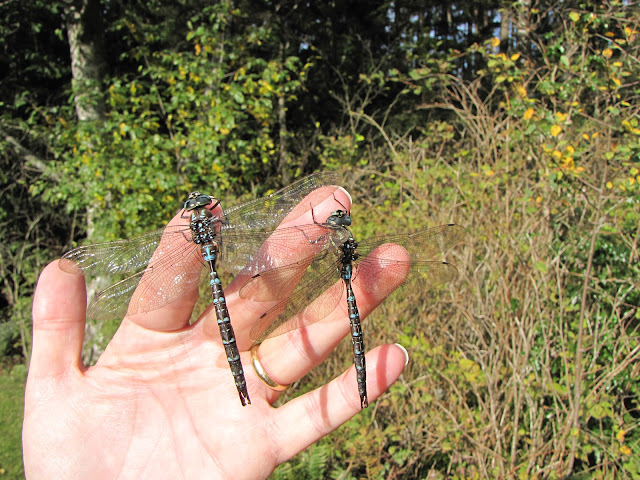Field marks are the bread-and-butter of birding and dragonflying. Having a good suite of field marks for a particular species is important in accurate identification, because a single field mark can be variable or hard to see in a particular situation.
For example, when identifying Hutton's Vireo it's useful to keep in mind a variety of good field marks that distinguish it from the Ruby-crowned Kinglet. The vireo has light-colored lores, wing bars that lack a dark border, and black feet (as opposed to the yellow feet of the kinglet.) It's common for only one or two of these field marks to be visible on a given individual as it hops from branch to branch in the bushes, so having a number of field marks to work with can be quite helpful.
With that in mind, a similar situation occurs when identifying certain darners that are quite similar in appearance. For example, Shadow Darners lack blue spots on the tenth segment of their abdomens (S10), whereas Paddle-tailed Darners (Happy-face Darner) do have blue spots on S10. The tenth segment of the abdomen isn't always easy to get a look at, and so other field marks are useful, like a strong facial line in the Paddle-tailed Darner that is lacking in the Shadow Darner.
Another field mark that I find to be useful for a number of different darners is the blue stripe that appears on the dorsal surface of S2. For orientation, the "wasp waist" in male darners is S3, and S2 is the bulbous segment closer to the thorax. Here is a photo comparison of the dorsal stripe in four different, but similar-looking darners.
 |
| A comparison of blue dorsal stripes on four different darner species. The stripes vary from thin and straight to broad and spindle shaped, to half a stripe, to a stripe that is wider at the base that the top. |
The blue dorsal stripe is straight, thin, and fairly uniform in the Paddle-tailed Darner. In the Shadow darner it is broad and spindle shaped – almost like a chess piece. Only half a stripe appears on the Variable Darner, and Walker's Darner has a stripe that is wider at the base than at the top. I need to work more on these to see how consistent they are, and how they can be extended to other species as well.
Here's a gallery of photos showing these darners. Check out the dorsal stripes as an additional means of identification:
 |
| Paddle-tailed Darner (Happy-face Darner). Note the thin, straight, uniform dorsal stripe on S2. |
 |
| Again, a nice Paddle-tailed Darner (Happy-face Darner). You can't see S10 in this photo, but the dorsal stripe on S2 is quite definitive. |
 |
| A triplet of free-range darners. From lef to right we have Shadow, Shadow, Paddle-tailed. These dragonflies were never captured – simply lifted one at a time onto my fingers. They were free to fly away at any time. |
 |
| A Shadow Darner shows off his broad dorsal stripe on S2. |
 |
| Two free-range Shadow Darners. |
 |
| A Variable Darner sports just half a stripe on S2. |
 |
| Walker's Darner has a dorsal stripe on S2 that is wider at the base than at the top. |
 |
| A closer look at the dorsal stripe on S2 for a Walker's Darner. |
I've enjoyed using this field mark, and will continue to apply it and test it out for consistency and dependability.









Thank you for this post! I found a dragonfly in the grass (it was dead) and thought it was beautiful so I pinned it in a shadow box. Your advice leads me to believe that it is a Paddle-tailed Darner.
ReplyDelete